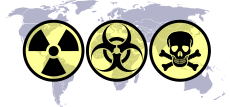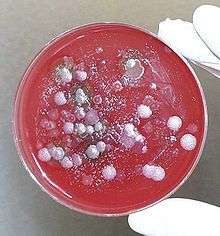Biological agent
A biological agent (also called bio-agent, biological threat agent, biological warfare agent, biological weapon, or bioweapon) is a bacterium, virus, protozoan, parasite, or fungus that can be used purposefully as a weapon in bioterrorism or biological warfare (BW).[1] In addition to these living or replicating pathogens, toxins and biotoxins are also included among the bio-agents. More than 1,200 different kinds of potentially weaponizable bio-agents have been described and studied to date.
| Weapons of mass destruction |
|---|
 |
| By type |
| By country |
|
| Proliferation |
| Treaties |
|

Biological agents have the ability to adversely affect human health in a variety of ways, ranging from relatively mild allergic reactions to serious medical conditions, including serious injury, as well as serious or permanent disability or even death. Many of these organisms are ubiquitous in the natural environment where they are found in water, soil, plants, or animals.[1] Bio-agents may be amenable to "weaponization" to render them easier to deploy or disseminate. Genetic modification may enhance their incapacitating or lethal properties, or render them impervious to conventional treatments or preventives. Since many bio-agents reproduce rapidly and require minimal resources for propagation, they are also a potential danger in a wide variety of occupational settings.[1]
The Biological Weapons Convention (1972) is an international treaty banning the use or stockpiling of bio-agents; as of February 2015, there were 171 state signatories.[2] Bio-agents are, however, widely studied for both defensive and general medical purposes under various biosafety levels and within biocontainment facilities throughout the world.
Classifications
Operational
The former US biological warfare program (1943-1969) categorized its weaponized anti-personnel bio-agents as either "lethal agents" (Bacillus anthracis, Francisella tularensis, Botulinum toxin) or "incapacitating agents" (Brucella suis, Coxiella burnetii, Venezuelan equine encephalitis virus, Staphylococcal enterotoxin B).[3]
Legal
Since 1997, United States law has declared a list of bio-agents designated by the U.S. Department of Health and Human Services or the U.S. Department of Agriculture that have the "potential to pose a severe threat to public health and safety" to be officially defined as "select agents" and possession or transportation of them are tightly controlled as such.[4] Select agents are divided into "HHS select agents and toxins", "USDA select agents and toxins" and "Overlap select agents and toxins".
Regulatory
The U.S. Centers for Disease Control and Prevention (CDC) breaks biological agents into three categories: Category A, Category B, and Category C. Category A agents pose the greatest threat to the U.S. Criteria for being a Category "A" agent include high rates of morbidity and mortality; ease of dissemination and communicability; ability to cause a public panic; and special action required by public health officials to respond. Category A agents include anthrax, botulism, plague, smallpox, tularemia, and viral hemorrhagic fevers.
List of bio-agents of military importance
- The following pathogens and toxins were weaponized by one nation or another at some time. NATO abbreviations are included where applicable.
Bacterial bio-agents
| Disease | Causative Agent (Military Symbol) |
|---|---|
| Anthrax | Bacillus anthracis (N or TR) |
| Brucellosis (bovine) | Brucella abortus |
| Brucellosis (caprine) | Brucella melitensis (AM or BX) |
| Brucellosis (porcine) | Brucella suis (US, AB or NX) |
| Cholera | Vibrio cholerae (HO) |
| Diphtheria | Corynebacterium diphtheriae (DK) |
| Dysentery (bacterial) | Shigella dysenteriae, some species of Escherichia coli (Y) |
| Glanders | Burkholderia mallei (LA) |
| Listeriosis | Listeria monocytogenes (TQ) |
| Melioidosis | Burkholderia pseudomallei (HI) |
| Plague | Yersinia pestis (LE) |
| Tularemia | Francisella tularensis (SR or JT) |
Chlamydial bio-agents
| Disease | Causative Agent (Military Symbol) |
|---|---|
| Psittacosis | Chlamydophila psittaci (SI) |
Rickettsial bio-agents
| Disease | Causative Agent (Military Symbol) |
|---|---|
| Q Fever | Coxiella burnetii (OU) |
| Rocky Mountain spotted fever | Rickettsia rickettsii (RI or UY) |
| Typhus (human) | Rickettsia prowazekii (YE) |
| Typhus (murine) | Rickettsia typhi (AV) |
Viral bio-agents
| Disease | Causative Agent (Military Symbol) | Comments |
|---|---|---|
| Equine Encephalitis (Eastern) | Eastern equine encephalitis virus (ZX) | |
| Equine Encephalitis (Venezuelan) | Venezuelan Equine Encephalomyelitis virus (FX) | |
| Equine Encephalitis (Western) | Western equine encephalitis virus (EV) | |
| Japanese B encephalitis | Japanese encephalitis virus (AN) | |
| Marburg Hemorrhagic Fever (Marburg HF) | Marburg Virus (MARV) | by the Soviet Union[5] |
| Rift Valley fever | Rift Valley fever virus (FA) | |
| Smallpox | Variola virus (ZL) | |
| Yellow fever | Yellow fever virus (OJ or LU) |
Mycotic bio-agents
| Disease | Causative Agent (Military Symbol) |
|---|---|
| Coccidiomycosis | Coccidioides immitis (OC) |
Biological toxins
| Toxin | Source of Toxin (Military Symbol) |
|---|---|
| Abrin | Rosary pea (Abrus precatorius) |
| Botulinum toxins (A through G) | Clostridium botulinum bacteria or spores, and several other Clostridial species. (X or XR) |
| Ricin | Castor bean (Ricinus communis) (W or WA) |
| Saxitoxin | Various marine and brackish cyanobacteria, such as Anabaena, Aphanizomenon, Lyngbya, and Cylindrospermopsis (TZ) |
| Staphyloccocal enterotoxin B | Staphylococcus aureus (UC or PG) |
| Tetrodotoxin | Various marine bacteria, including Vibrio alginolyticus, Pseudoalteromonas tetraodonis (PP) |
| Trichothecene mycotoxins | Various species of fungi, including Fusarium, Trichoderma, and Stachybotrys |
Biological vectors
| Vector (Military Symbol) | Disease |
|---|---|
| Mosquito (Aedes aegypti) (AP) | Malaria, Dengue fever, Chikungunya, Yellow fever, other Arboviruses |
| Oriental rat flea (Xenopsylla cheopis) | Plague, Murine typhus |
Simulants
Simulants are organisms or substances which mimic physical or biological properties of real biological agents, without being pathogenic. They are used to study the efficiency of various dissemination techniques or the risks caused by the use of biological agents in bioterrorism.[6] To simulate dispersal, attachment or the penetration depth in human or animal lungs, simulants must have particle sizes, specific weight and surface properties, similar to the simulated biological agent.
The typical size of simulants (1-5 µm) enables it to enter buildings with closed windows and doors and penetrate deep into the lungs. This bears a significant health risk, even if the biological agent is normally not pathogenic.
- Bacillus globigii (historically named Bacillus subtilis in the context of bio-agent simulants) (BG, BS, or U)
- Serratia marcescens (SM or P)
- Aspergillus fumigatus mutant C-2 (AF)
- Escherichia coli (EC)
- Bacillus thuringiensis (BT)
- Erwinia herbicola (current accepted name: Pantoea agglomerans) (EH)
- Fluorescent particles such as Zinc cadmium sulfide, ZnCdS (FP)
In popular culture
See also
- Biological hazard
- Biological contamination
- Laboratory Response Network
- Pulsed ultraviolet light
- Toxin
References
- "Biological Agents". United States Department of Labor: OSHA. Retrieved 2012-05-31.
- "Convention on the Prohibition of the Development, Production and Stockpiling of Bacteriological (Biological) and Toxin Weapons and on their Destruction". United Nations Office for Disarmament Affairs. Retrieved 2013-03-03.
- Headquarters, Departments of the Army, the Navy, and the Air Force, and Commandant, Marine Corps (17 July 2000), Field Manual: Treatment of Biological Warfare Casualties (Army FM 8-284/Navy NAVMED P-5042/Air Force AFMAN (I) 44-156/Marine Corps MCRP 4-11.1C), para 1-4 (pg 1-3).
- Additional Requirements for Facilities Transferring or Receiving Select Agents, Title 42 CFR Part 72 and Appendix A; 15 April 1997 (DHHS).
- Kenneth Alibek and S. Handelman. Biohazard: The Chilling True Story of the Largest Covert Biological Weapons Program in the World - Told from Inside by the Man Who Ran it. 1999. Delta (2000) ISBN 0-385-33496-6.
- "Biological Warfare (BW) Simulants – Bacillus globigii (BG)". The Night Ferry. 2010-02-05. Retrieved 2017-04-03.